STOP FROZEN WATERERS
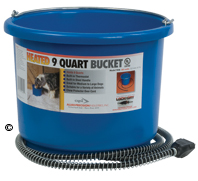
Strong steel handles don’t become brittle (like plastic handles) in cold temperatures.
Heated Buckets
For watering livestock and pets in winter months. Keeps water from freezing. Wire spring protects cord to prevent damage from animal’s teeth. Built-in thermostat turns bucket’s heater on at 40ºF and off at 60ºF. 6 ft cord. 1 year warranty.
We offer the following:
Also available from Premier—Feeding Buckets.
USEFUL COLD WEATHER TOOL
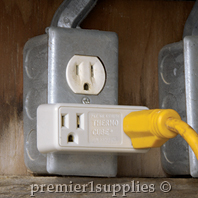 ThermoCube
ThermoCube
Saves electricity $$.
Quickly repays initial cost.
Automatically turns power on and off according to air temperature around the cube—on at less than approximately 35ºF and off at 45ºF.
To use, plug it into an outlet and then plug heat lamps, buckets, engine block heaters, etc. into ThermoCube.
DE-ICERS
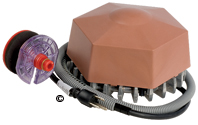 3-in-1 De-Icer
3-in-1 De-Icer
Unique because it can be changed to float or sit on the tank bottom. Patented design allows electrical cord, if you wish, to pass out through the tank’s drain plug for better protection.
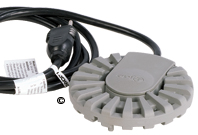 Bucket De-Icer
Bucket De-Icer
Sits inside at bottom of buckets or small water tanks. Built-in thermostat turns on at 40ºF and off at 60ºF.
|
 |
 |
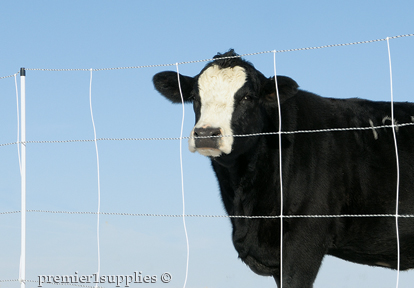
The cow in the photo is thinking about test-tasting the RFV (relative feed value) of the forage on the other side of the fence. Fortunately, the fence is tried and true Cattle QuikFence™, so she'll stay right where she is suppose to.
Winter Feed & Water for Cattle
DId you know that for each pound of dry matter consumed, a cow needs 7 pounds of water? That factoid plus a few more is covered in the articles below. Covered topics are winter water consumption needs and late gestation feeding. Enjoy the articles below, we suspect they will prove useful for the management of your bovine herd.
COW/CALF NUTRITION
Winter Feeding Forages
for Beef Cows
Alfredo DiCostanzo and Jay C. Meiske, University of Minnesota
INTRODUCTION
Cows have been consuming forages for thousands of years for their survival. This would indicate that there is little or no need for man to become involved with this age-old process. However, when cows are a part of a larger enterprise—the commercial cow herd for profit—there is little doubt that man needs to become aware of available forages and their quality, and cow nutrient requirements during winter.
In most situations in the upper Midwest, winter feeding includes the middle and last trimester of gestation, and a portion of the first trimester of lactation. Most winter feeding is accomplished with harvested forages — hays and silages. Nutrient requirements of beef cows are low (Table 1) compared to those of other cattle (dairy or feedlot). This may encourage some producers to consider winter feeding a low priority issue. However, even in areas of Minnesota where pasture is the main source of forages, producers fed, on average, over 600 lb of grain, 8264 lb of hay and 2500 lb of silage per cow in 1991 (MN Farm Bus. Mgmt. Areas, 1991).
Utilizing Table 1 to generate annual energy requirements for a 1200 lb cow yielded 4391 lb TDN. From the grain, hay and silage totals for Minnesota pasture-based systems, and assuming 89, 90 and 30% dry matter (DM) and 88, 55 and 62% TDN, respectively, the annual TDN on these average farms was 5026 lb. This estimate does not include summer pasture contribution to TDN. Thus, it is apparent that management of supplemental grain and forage expenditure on beef farms may have room for improvement.
Read More »
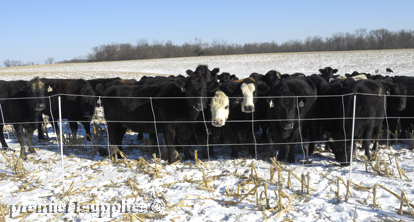
EXTENSION NEWS
Access to Water Critical for Wintering Beef Cattle
By Rhonda R. Gildersleeve, UW Extension Grazing Specialist, featured in January 2012 Wisconsin Agriculturalist
Cattle need daily access to water to meet their needs during winter months, although the total amount consumed decreases compared to warmer weather conditions. Water intake by beef cattle is quite constant up to 40⁰F. Table 1 lists the expected daily water intake of various classes of beef cattle under cool temperature conditions.
In colder weather, cattle need to consume more feed to meet energy needs. For every 1 pound of dry matter consumed, cattle need to drink about 7 pounds of water to maintain desired levels of dry matter intake. Animal performance suffers because feed intake is suppressed when adequate access to good quality water is not available to meet their needs. As a result, feedlot gains, lactation levels, and calf growth rates are reduced and farm production goals will be impacted.
Some producers have questioned the need for a year round water supply, since snow is usually available during winter months. Limited research has been conducted on use of snow as a sole water source for out-wintered cattle. Canadian researchers reported that mature cows in adequate body condition (score 5 or higher) can maintain themselves and their calves with snow as the only water resource. However, another study reported that weaned calves (450 – 600 pounds) had lower average daily gains (- 0.2 lbs) and reduced feed efficiency compared to calves with access to water.
Read More »
|
|